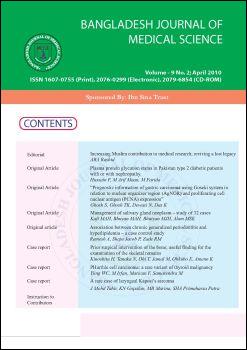A rare case of laryngeal Kaposis sarcoma
DOI:
https://doi.org/10.3329/bjms.v9i2.5660Keywords:
Airway obstruction, Laryngeal, Kaposis sarcoma, HIVAbstract
Kaposi’s sarcoma (KS) is the most common malignancy observed in patient with acquired immune deficiency syndrome (AIDS). It rarely causes upper airway obstruction. We report a 39-year-old gentleman, a former intravenous drug user with AIDS and Hepatitis C positive who developed progressive hoarseness with stidor. He underwent an emergency tracheostomy and direct laryngoscopy revealed a whitish globular laryngeal mass obscuring the glottic region. A biopsy of the mass was taken and the histopathological report showed evidence of spindle cell connective tissue, consistent with Kaposi’s sarcoma. It is important for clinicians or surgeons to maintain a high index of suspicion for the diagnosis of laryngeal KS in immunodeficiency patient even without cutaneous manifestation.
Keywords: Airway obstruction; Laryngeal; Kaposi’s sarcoma; HIV.
DOI: 10.3329/bjms.v9i2.5660
Bangladesh Journal of Medical Science Vol.09 No.2 Apr 2010 pp.107-109
Downloads
399
197
Downloads
Published
How to Cite
Issue
Section
License
Authors who publish in the Bangladesh Journal of Medical Science agree to the following terms that:
- Authors retain copyright and grant Bangladesh Journal of Medical Science the right of first publication of the work.

Articles in Bangladesh Journal of Medical Science are licensed under a Creative Commons Attribution 4.0 International License CC BY-4.0.This license permits use, distribution and reproduction in any medium, provided the original work is properly cited.- Authors are able to enter into separate, additional contractual arrangements for the distribution of the journal's published version of the work (e.g., post it to an institutional repository or publish it in a book), with an acknowledgement of its initial publication in this journal.
- Authors are permitted to post their work online (e.g., in institutional repositories or on their website) as it can lead to productive exchanges, as well as greater citation of published work.




